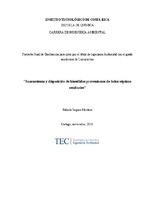Saneamiento y disposición de biosólidos provenientes de lodos sépticos residuales
Abstract
In Costa Rica, the septic tank is the single largest treatment for domestic wastewater, and its use grows every year. The generation of residual sludge derived from the purging of the tanks, their treatment and final disposal is little controlled by the authorities. Nowadays there are few companies authorized for such purpose. In addition, they lack regulations that allow them to use reliable microbiological or physicochemical indicators to evaluate their performance; and there are no practical guides for the treatment of sludge and final disposal of biosolids. Therefore, this research studies two techniques known as "emergency" for the sanitary treatment of septic sludge, at laboratory scale. Lactic Acid Fermentation (LAF), by three lactic acid bacteria strains: Lactobacillus casei, Lactobacillus acidophilus and Mix, and three sources of carbon: carrot, molasses and dextrose. In addition to liming with "quicklime" (CaO = 105.5% CaCO3) and "slaked lime" (Ca (OH) 2 = 75% CaCO3). Also, the solar drying phase present in the sewage treatment plant of an authorized company is evaluated. The starting sludge was characterized with physicochemical and microbiological tests and the total coliforms were selected as suitable indicator microorganisms. The optimal doses for FAL were 0.22 g dextrose / g sludge and 0.20 g molasses / g sludge, reaching a pH of ≤ 3.89 and a 100% effectiveness for the elimination of coliforms. On the other hand, the dose of 0.12 g CaO / g sludge was more successful compared to the use of slaked lime, reaching a pH > 12 and 100% effectiveness for the elimination of the indicator microorganism. After evaluating the removal efficiency and costs, liming treatment with CaO was established as the most viable. The results obtained are promising for septic sludge treatment, however, it is important to consider its physicochemical and microbiological heterogeneity and consequently the need to adjust the liming curves prior to treatment.
Description
Proyecto de Graduación (Licenciatura en Ingeniería Ambiental) Instituto Tecnológico de Costa Rica, Escuela de Química, 2018.


